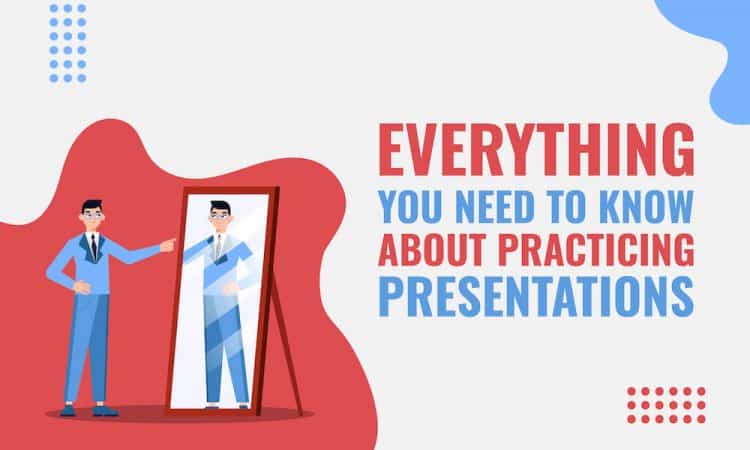
Standing on the stage, I forgot how I was supposed to elaborate on that point.
There were a few words that were too difficult to pronounce, and they got the better of me.
My presentation stretched for more than the stipulated time.
The unfamiliarity with the content made me struggle with questions from the audience.
These, and another ‘n’ number of scenarios, are probable situations that can happen to any of us when presenting. And there is a common cause to all of them – lack of preparation and practice. By not rehearsing enough, you can find yourself in a lot of uncomfortable situations on your D-day as you enter an untried zone.
Let’s look at it another way.
Simulations are normal in every field. In fact, the higher the stakes, the harder the preparation is. Astronauts, doctors, pilots, and military personnel – all are vigorously prepared for pressure-packed situations in environments akin to what they will be operating in. The repeated exposure enables them to remain calm and prepared for the actual situation.
Similarly, rehearsing can help presenters deal with stage fright, be comfortable with the presentation, and deliver effortlessly.
The article is a guide on everything you should know about perfecting your presentation through practice. Read on.
Importance and Benefits of Practicing
Chris Hadfield, in his now famous TED talk, recounts how he went blind in space and got out of the situation because of his countless spacewalk practice sessions in simulators.
Let’s go through the reasons why you should practice and rehearse before getting on the podium.
1. Let Go of the Speaking Anxiety
If you are like most people and don’t have a knack for public speaking, the idea of presenting probably will give jitters to you. The fact is – a lot of people face anxiety and tension while facing a crowd. It takes away their energy, and the nervousness and anxiousness can make them look incompetent.
Practicing well (in front of people) will take care of that problem. The repetitive exposure will normalize the experience for you, helping you calm your nerves naturally. So, when you finally face the crowd, all everyone will see is a confident speaker who knows what he is saying.
2. Better Time Management
Regardless of where you are as a speaker, you will always have a time limit, which you need to manage effectively. If you haven’t practiced, you will not know the elements of your presentation properly and how much time each requires.
Imagine running late due to lack of practice and having to apologize for leaving out critical information, or worse, rushing through parts to complete on time. It can leave you in a really messy state as a speaker.
Adequate practice will help you time yourself and not miss out on anything essential.
3. You will get a Refined End Product
Oftentimes, while preparing, you end up including a lot of information that seems important. Lack of practice will make you take that 1st draft with maybe a few edits to your audience. The result is a barrage of information that will make people lose attention and get confused. We surely don’t want that to happen to us, right?
Repetitive practice sessions will make you trim down that information each time, leading to a more concise, crisp, and relevant slide.
Subsequent eliminations and refinement can only happen when you have gone through that piece many times.
4. Improved Body Language and Gestures
When you present, all eyes are on you. So, they will naturally assess everything from how you stand and move your arms to your facial expressions and words. Oftentimes, we take care of content and our delivery but forget that body language is as critical as those elements when you present.
Practicing eye contact and proper body language beforehand will make you appear natural, in control, and relaxed on stage and not forced or phony.
Like any other muscle memory, you will not have to pay too much attention to taking care of different elements of body language with adequate practice.
5. Eliminate Speaking Flaws
Constant practicing will help you get rid of speaking flaws. There are a lot of words we might be pronouncing wrong, tongue twisters, unnecessary abbreviations and acronyms, difficult-to-pronounce words (in general), or poorly worded sentences that can benefit a lot from practicing.
You will be more fluid and comfortable in your talk if you are aware of your presentation, word by word. Also, repeated mistakes (while practicing) can make you aware of what needs alteration in your speech.
6. Try Something Novel
Rehearsals can give you the space to try something new. You can try different kinds of openings, cue-in for multimedia shows, some lighting effects, props and demonstrations, etc.
Practice sessions beforehand will give you the space and time to figure out what works best and eliminate things that don’t appear as catchy as they seemed in your head.
Ways and Tips to Practice
Below are some tips and techniques that will help you strengthen your practice and set you off for sure success.
1. Recreate the Environment
You can practice in the same room you will be presenting in for a real experience. Recreate everything the way it would be for an actual presentation. That includes using visual cues, moving around the room, and taking the help of technological tools.
It would also be great to reach the venue an hour or so earlier and test-run your presentation to make sure everything runs smoothly.
2. Go for 10x Improvement
Now, this might seem a little subjective, but the concept traces its origin to Larry Page (Google’s co-founder). He proposed that the products should be 10 times better than the competition; otherwise, they all look the same (source: Wired). Similarly, if you want to deliver a spellbinding presentation – more impactful than your peers – practice ten times harder than everyone.
Dr Jill Bolte Taylor practiced her famous TED talk around 200 times.
10x rehearsals are not as intimidating as it sounds. Repeat the introduction while driving or taking a stroll. Difficult parts can be practiced out loud whenever possible.
3. Practice Introduction and Conclusion Well
Do you know why the introduction and conclusion of your speech are so important? The former sets the tone for the entire thing and will make people find their interest. The latter will determine the key takeaway points and how your presentation was received overall. You don’t want to risk sounding monotonous by memorizing your presentation verbatim.
The target is to be confident while leaving the room for spontaneity.
A TED talk might seem like a good case for a memorized presentation as the time limit is strict. But for the other ones, try to nail down the 1st and last two minutes of the presentation along with 1st and last lines of each slide. The technique will really put you far ahead of others in your practice time.
4. Rehearse Under Mild Stress
According to research, practicing under even mild stress can do wonders for your delivery. Practicing in front of the mirror or in your mind is not the same as standing in front of a crowd.
The real-world conditions can expose you to the worst fears about public speaking but in manageable doses (since it’s just a dry run). Your body will react as expected initially – increased heart rate, sweaty palms, etc.
But practicing in front of an audience, even if it’s just 3-4 people, your body will grow accustomed and stop exhibiting the nervous signs. The key benefit – practicing under a mild amount of stress will prevent you from choking under higher levels of stress (actual presentation).
One example is the author, Susan Cain, a self-described introvert. For her TED talk, her friend (a Wharton professor) gathered 30 of his students to watch her practice. The mild amount of stress helped her deal with her fears manageably, resulting in a super successful talk and catapulting her career as a public speaker (source: Inc).
5. Capture It
Recording your presentation will immediately make you take notice of distracting habits (if any) like brushing or flipping through hair, reusing comfort words, fidgeting, avoiding eye contact, etc.
All this might be okay in normal informal conversations, but you wouldn’t want to continue that standing next to a lectern. Figure out areas where you are unsure of yourself or sections where your words are mumbled. These are the ones which need proper attention.
By recording yourself, you can take care of everything from your content (what seemed interesting enough), body language (if it was open and inviting), and facial expressions (warm or poker) to your speech (coherent or fumbled).
6. Always Take Feedback
Silicon Valley legend John Chambers (ex-chairman of Cisco) mentions his practice of rigorous rehearsing and taking feedback even after being a renowned public speaker during his 20 years at the company. (source: Forbes)
The presentations were meticulously prepared, to the point that body gestures, facial expressions, messages, delivery, interactions with others, etc., everything was rehearsed. The orator spent hours practicing, recorded sessions, watched them with the team, and took feedback. The process continued throughout his journey as a speaker, which paid him well.
When you are open to feedback from others, it is as many eyes and opinions that can pinpoint things you might have missed individually. You can go for corrections that much faster and refine your speech and presentation slides.
7. Use Memory-Boosting Techniques to Amplify Your Practice Sessions
Since we don’t want to memorize our entire presentation, which is right as well, memory-boosting techniques can solve our issue of remembering everything.
You can mark certain trigger words or keywords to help you remember better. Similarly, you can use visual clues to create a mind map of your presentation. It will help you navigate everything seamlessly without having to fidget through flashcards and notes.
There are other techniques like Mnemonics, spaced repetitions, visual connections, acronyms, etc., which can help you retain information without having to learn your presentation by rote.
Final Thoughts
Presentation is one of the best forms of communication, even if in a formalized structure. You get to speak to a number of people at once and deliver your important message. And guess what; a great presentation can become your competitive weapon too, as it can do so much, like launch careers, attract investments, inspire and educate people, etc.
To ensure that the process runs smoothly, it is imperative that you practice as much as possible beforehand, as it will be the best use of your time before the big day. Take the help of practicing techniques like audio/visual recordings, delivery feedback, etc., to amplify the development process of your presentation.
Adequate practice will ease the pressure off you and result in a flawless and impactful presentation delivery. It will help calm your nerves, eliminate flaws, and improve your timing and delivery.
Take the help of the tips and techniques to tread the journey of a great presenter from a good one.



